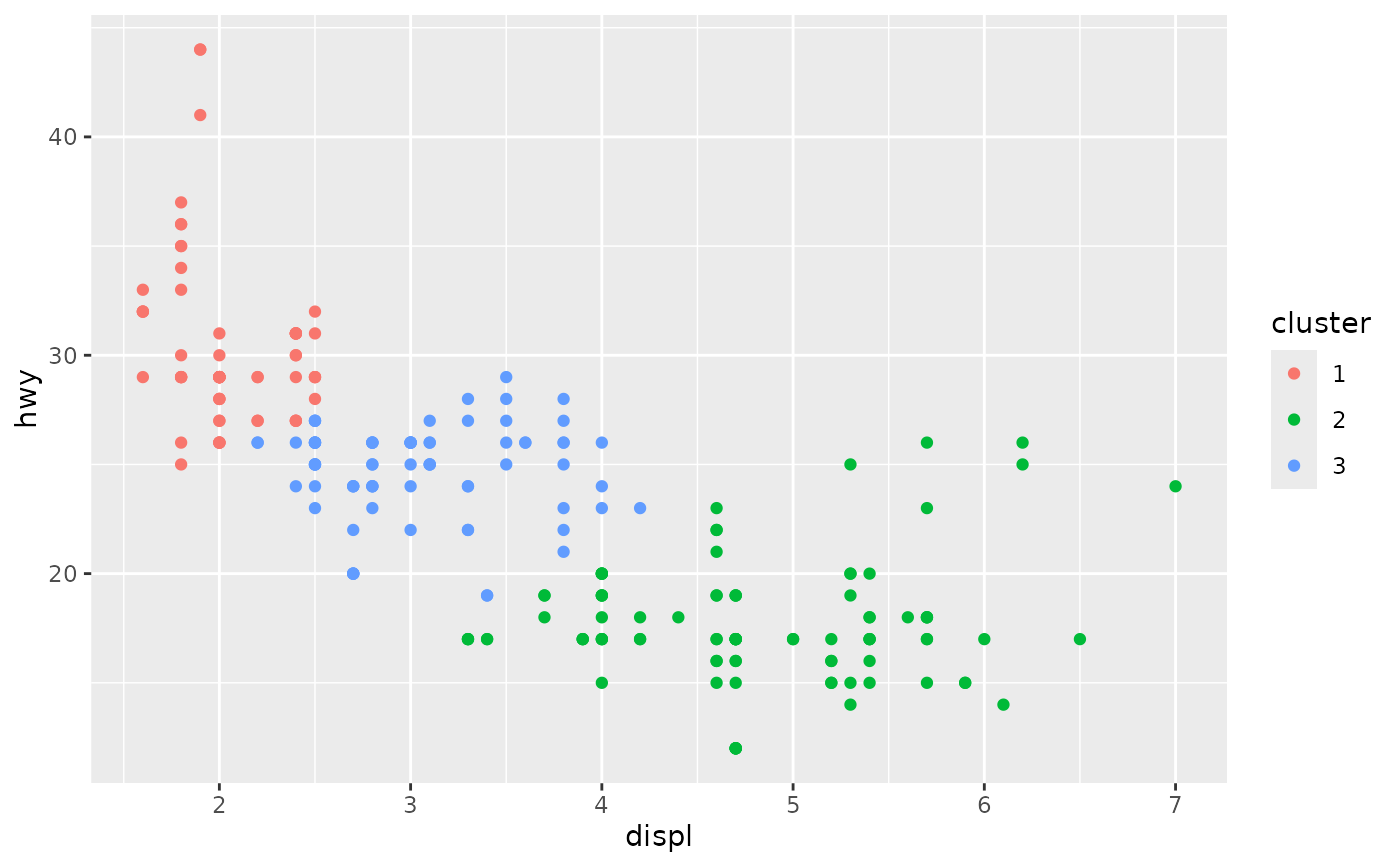All stat_*() functions (like stat_bin()) return a layer that
contains a Stat* object (like StatBin). The Stat*
object is responsible for rendering the data in the plot.
Details
Each of the Stat* objects is a ggproto() object, descended
from the top-level Stat, and each implements various methods and
fields. The object and its parameters are chaperoned by the Layer class.
To create a new type of Stat object, you typically will want to override one or more of the following:
The
required_aesanddefault_aesfields.One of the
compute_layer(),compute_panel()orcompute_group()functions. Typically it best to implementcompute_group()and use the higher-up methods when there are substantial performance improvements to be gained.The
finish_layer()method
Fields
required_aesA character vector naming aesthetics that are necessary to compute the stat.
non_missing_aesA character vector naming aesthetics that will cause removal if they have missing values.
optional_aesA character vector naming aesthetics that will be accepted by
layer(), but are not required or dscribed in thedefault_aesfield.default_aesA mapping of default values for aesthetics. Aesthetics can be set to
NULLto be included as optional aesthetic.dropped_aesA character vector naming aesthetics that can be dropped from the data without warning. Typically used for aesthetics that are 'consumed' during computation like
"weight".extra_paramsA character vector of parameter names in addition to those imputed from the
compute_panel()orcompute_groups()methods. This field can be set to include parameters forsetup_data()methods. By default, this only contains"na.rm".retransformA scalar boolean: should the values produced by the statistic also be transformed in the second pass when recently added statistics are trained to the scales
setup_paramsDescription
A function method for modifying or checking the parameters based on the data. The default method returns the parameters unaltered.
Usage
Stat$setup_params(data, params)Arguments
dataA data frame with the layer's data.
paramsA list of current parameters
Value
A list of parameters
setup_dataDescription
A function method for modifying or checking the data. The default method returns data unaltered.
Usage
Stat$setup_data(data, params)Arguments
dataA data frame with the layer's data.
paramsA list of parameters coming from the
setup_params()method
Value
A data frame with layer data
compute_layerDescription
A function method for orchestrating the computation of the statistic. The default method splits the data and passes on computation tasks to the panel-level
compute_panel()method. In addition, the default method handles missing values by removing rows that have missing values for the aesthetics listed in therequired_aesandnon_missing_aesfields. It is not recommended to use this method as an extension point.Usage
Stat$compute_layer(data, params, layout)Arguments
dataA data frame with the layer's data.
paramsA list of parameters
layoutA pre-trained
<Layout>ggproto object.
Value
A data frame with computed data
compute_panel,compute_groupDescription
A function method orchestrating the computation of statistics for a single panel or group. The default
compute_panel()method splits the data into groups, and passes on computation tasks to thecompute_group()method. In addition,compute_panel()is tasked with preserving aesthetics that are constant within a group and preserving these if the computation loses them. The defaultcompute_group()is not implemented.Usage
Stat$compute_panel(data, scales, ...) Stat$compute_group(data, scales, ...)Arguments
dataA data frame with the layer's data.
scalesA list of pre-trained
xandyscales. Note that the position scales are not finalised at this point and reflect the initial data range before computing stats....Reserved for extensions. By default, this passes parameters to the
compute_group()method.
Value
A data frame with layer data
finish_layerDescription
A function method acting as a hook to modify data after scales have been applied, but before geoms have to render. The default is to pass the data unaltered. This can be used as an extension point when actual aesthetic values rather than values mapped to the aesthetic are needed.
Usage
Stat$finish_layer(data, params)Arguments
dataA data frame with layer data
paramsA list of parameters
Value
A data frame with layer data
parametersDescription
A function method for listing out all acceptable parameters for this stat.
Usage
Stat$parameters(extra)Arguments
extraA boolean: whether to include the
extra_paramsfield.
Value
A character vector of parameter names.
aestheticsDescription
A function method for listing out all acceptable aesthetics for this stat.
Usage
Stat$aesthetics()Value
A character vector of aesthetic names.
Conventions
The object name that a new class is assigned to is typically the same as the
class name. Stat class names are in UpperCamelCase and start with the Stat*
prefix, like StatNew.
A constructor function is usually paired wih a Stat class. The constructor
wraps a call to layer(), where e.g. layer(stat = StatNew). The
constructor function name is formatted by taking the Stat class name and
formatting it with snake_case, so that StatNew becomes stat_new().
See also
The new stats section of the online ggplot2 book..
Run vignette("extending-ggplot2"), in particular the "Creating a
new stat" section.
Other Layer components:
Geom,
Layer-class,
Position
Examples
# Extending the class
StatKmeans <- ggproto(
"StatKmeans", Stat,
# Fields
required_aes = c("x", "y"),
# You can relate computed variables to aesthetics using `after_stat()`
# in defaults
default_aes = aes(colour = after_stat(cluster)),
# Methods
compute_panel = function(data, scales, k = 2L) {
km <- kmeans(cbind(scale(data$x), scale(data$y)), centers = k)
data$cluster <- factor(km$cluster)
data
}
)
# Building a constructor
stat_kmeans <- function(mapping = NULL, data = NULL, geom = "point",
position = "identity", ..., k = 2L, na.rm = FALSE,
show.legend = NA, inherit.aes = TRUE) {
layer(
mapping = mapping, data = data,
geom = geom, stat = StatKmeans, position = position,
show.legend = show.legend, inherit.aes = inherit.aes,
params = list(na.rm = na.rm, k = k, ...)
)
}
# Use new stat in plot
ggplot(mpg, aes(displ, hwy)) +
stat_kmeans(k = 3)

